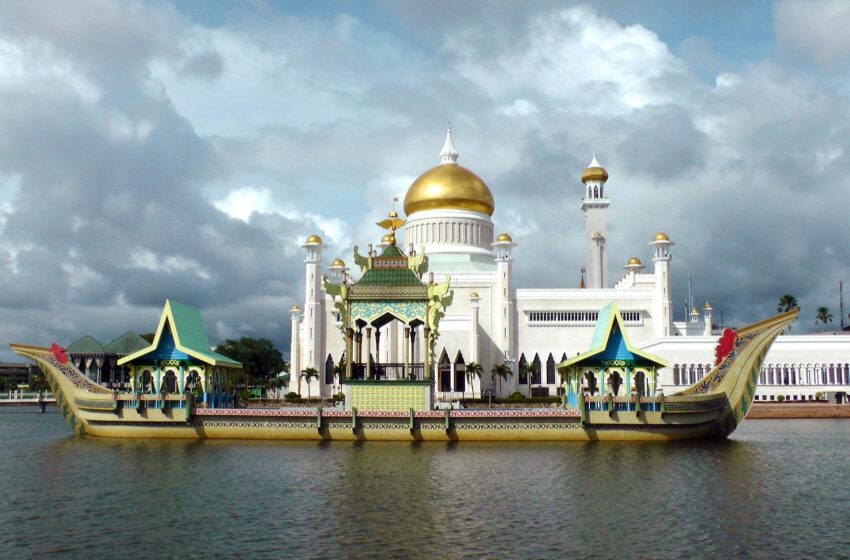
Brunei’s Only Travel Guide You Need For A Great Trip in 11 Easy Steps
- Destinations Asia
Cruisit Team
- June 16, 2022
- 0
- 4705
- 69 minutes read
Brunei’s Background
The dominance of the Sultanate of Brunei peaked between the 15th and 17th centuries when it ruled over coastal portions of northwest Borneo and the southern Philippines. Brunei later underwent a period of decline caused by internal turmoil over royal succession, European colonial expansion, and piracy. Brunei became a British protectorate in 1888 and gained independence in 1984. The country has been controlled by the same family for nearly six centuries, making it one of the longest standing hereditary kingdoms remaining in the modern world, the longest being Japan’s Monarchy. Brunei benefits from huge petroleum and natural gas resources, which contribute to one of the world’s greatest per capita GDPs.
Brunei is a tiny, strangely shaped island in the South China Sea, divided in two by the Malaysian state of Sarawak in the east. Despite being ruled by an authoritarian Sultan, most residents are content with the arrangement, thanks in part to the great riches generated by the massive oil deposits lying within its borders. This tiny country has a land area of only 2,200 square miles and is located on the island of Borneo, which it shares with the much bigger countries of Malaysia and Indonesia. Even if you’re not interested in a Brunei itinerary, it’s a useful piece of information to have for trivia evenings.
Brunei’s small sultanate is a relic of a maritime empire that once ruled all of Borneo and a portion of the modern-day Philippines. Nonetheless, this peaceful Darussalam (Arabic for “abode of peace”) boasts the greatest oilfields in Southeast Asia.
That is why the country of Brunei has long been associated with grandeur and oil wealth. In truth, little in this country of gleaming whitewashed mosques and golden-tipped minarets instantly contradicts that picture. Pumpjacks and the industrial workings of the Sultanate’s petroleum sector may be found in the west and all around the well-to-do metropolis of Bandar Seri Begawan. Rich, arabesque mansions and ambitious construction projects explode around every curve.
Oil has also helped to conserve much of the natural environment. Brunei boasts vast swaths of untouched rainforests, in contrast to Malaysia, which has cleared most of its forest to make place for palm oil plantations.
So, let’s not forget that this is Borneo either, and with Borneo comes actual wilderness. We’re talking lush jungles and volcanic summits. Primitive longhouse settlements line the valleys, and the odd sighting of a very uncommon clouded leopard! Granted, you’ll have to go deep into the country’s southern or eastern reaches to find them, but they’re always magnificently there.
“Known for its wealth in oil and strict rules, Brunei, the sovereign Sultanate, is the safest location in South East Asia and a hidden unspoiled Green Jewel waiting to be discovered by adventurous travelers.“
Looking behind the surface of this closely regulated sultanate reveals the judiciously maintained wildness of its natural environment, owing in part to the money provided by the oilfields. There is a lot of old-growth, primary forest, notably in the lush Ulu Temburong National Park.
Nature is therefore likely to be the major attraction that Brunei has to offer to any of its visitors. Yet, it’s not inexpensive. The country is pricey, and there is no tourist infrastructure. It just doesn’t need visitors to sustain its economy, so it doesn’t cater to them.
The implementation of a rigid interpretation of Sharia law in April 2019 has sparked international irritation and concern. Adultery and homosexual crimes are now punished by death by stoning, and theft is penalized by amputation of limbs. Though it is unrelated to the future of tourism the country can receive, it just filters out some of the crowd, or restricts some visitors’ actions while in the country.
Even so, if you manage to make it out into the forests, you will encounter a pristine environment that will make anyone forget any of their desires. If you don’t have the money, don’t worry; there are some other worthwhile attractions in this little Sultanate, practically all of which are situated in its capital, Bandar Seri Begawan. The stilt town of Kampung (or Kampong) Ayer, known as the Water Village, is situated just across the river and offers a taste of traditional Brunei life. The Omar Ali Saifuddien Mosque is charming any time of day. For a low-cost jungle adventure, travel to the Peradayan Forest Reserve near the little town of Bangar, a short boat journey from Bandar Seri Begawan and on the opposite side of Brunei.
If you’re still wondering why you should go to Brunei, we have an idea or two. One of the main reasons for considering Brunei is that it receives very few tourists. This is a significant draw in and of itself, especially for people who have grown tired of the crowds at the most popular destinations in the world. But the nation has a lot more to offer than just a lack of tourists. It is rich in unspoiled tropical rainforest paradises, one-of-a-kind Islamic architecture, and a vibrant cultural past. It is also one of the richest nations in the world because of its oil deposits, which can be seen everywhere and nowhere at the same time. Oh, and it’s one of the safest places to visit—yes, despite being rigid in its laws, or maybe that’s the reason it’s safe.
Brunei is well-known throughout Southeast Asia for its beautiful mosques and Islamic architecture. The Omar Ali Saifuddien and Jame’ Asr Hassanil Bolkiah Mosques in Bandar Seri Begawan are both popular tourist destinations for many of its travelers. With one standing on the Brunei River and shoreline with a beautiful artificial lagoon.
Let’s set politics aside. A country’s citizens should not be held accountable for the actions taken by their government, not to mention that none of us or our leaders can be a great judge of how other nations should operate. Instead, we should give ourselves and them the opportunity to engage in the cultural interchange carried by the adventures of tourism.
- Slower-paced Bandar Seri Begawan is the polar antithesis of flashy Dubai, and that is precisely what draws people to it. Discover some of its wonders by strolling through its calm streets or along the shore.
- Don’t miss the Omar Ali Saifuddien Mosque, which is especially lovely at night.
- Take a boat to Kampung Ayer, a stilt village adjacent to Bandar Seri Begawan.
- Visit the Peradayan Forest Reserve just outside Bangar for a low-cost jungle adventure.
- Visit Palau Selirong, a mangrove refuge, to see proboscis monkeys.
- Try scuba diving off the shore; you’ll most likely have the spots to yourself!
- Wander around Ulu Temburong National Park, Brunei’s famous Green Jewel
- Shop at the Bustling Gadong, with the largest bazaars and marketplaces
- The Youth Hostel in Bandar Seri Begawan is one of the country’s only well-known hostels, and you will most likely be the only one sleeping there. So, if at all feasible, stay at a youth hostel or use a hospitality exchange service like Couchsurfing.
- Brunei is a devoutly Islamic nation, therefore alcohol is prohibited, and you should be mindful of how you dress and act if you plan to visit the country.
- Bruneians are very educated, and while English will suffice, learning a few Malay words will be welcomed and appreciated by the locals.
- If you like to party, don’t go to Brunei. However, you will appreciate the culture more if you can let go of partying and stay sober for a bit.
- Almost all activities are free, therefore the expensive stays will be offset.
- There is no off-season for travel because there aren’t too many visitors.
- Getting into Brunei is simple, and most nations will just receive a three-month passport stamp upon arrival. US, UK, and EU passport holders along with many other Asian nationals can visit Brunei for more than 90 days. As a general rule, double-check ahead of time if this applies to you.
Crime & Scams in Brunei
Brunei is regarded to be the safest tourist destination in Southeast Asia, with very low crime rates other than maybe petty theft, however, it is still necessary to apply common sense to avoid getting into trouble. Brunei’s crime rate is roughly ten times lower than that of the United States and much of the developed world, and violent crime is extremely rare, notwithstanding recent increases in crime rates. Bruneians are rarely victims of vandalism or house invasions. Being mugged or robbed is incredibly rare, cars are almost never stolen, and violence of any type is few, regardless of gender, race, or religion. Armed robberies and assaults are infrequent, and the country as a whole has relatively low levels of corruption. This means you should feel very comfortable traversing the streets whether in daytime or at night, although of course avoid dark places with no people.
Healthcare in Brunei While Traveling
Brunei Darussalam, a small but affluent sultanate, provides free health care to citizens and permanent residents. However, 40 percent of the population who are foreign nationals on employment or tourist visas must pay for their health care. Brunei’s healthcare system is funded by the General Treasury. The healthcare system consists of around 15 health centers, 10 clinics, and 22 maternity and child healthcare institutions. There are also two private hospitals in the nation.
Before every trip, make sure you are up to date on all routine vaccinations. Among the key recommended vaccines globally are chickenpox (Varicella), diphtheria-tetanus-pertussis (DTP), influenza (flu), measles-mumps-rubella (MMR), polio, and shingles. Obtaining immunization cards for Yellow Fever, Hepatitis A and B, Typhoid, Rabies, and Meningitis is important when traveling.
When visiting Brunei, you are not required to purchase travel medical insurance. However, it is always important to have comprehensive medical coverage when traveling because you never know what you could encounter while overseas.
Brunei has two seasons: summer and the rainy season, separated by two transitional periods. The climate in Brunei is a blend of tropical equatorial and humid subtropical at high elevations, and as a consequence, there is a great deal of rainfall during the year. Throughout the year, humidity is high, with an average estimate of 80%, making it quite unpleasant. While tourism in the country is so insignificant to be able to determine peak, shoulder, and off seasons, we suggest them in terms of favorable weather. It’s unlikely you will find much of a difference in lodging prices between the seasons in Brunei as well.
Shoulder Season
The wet season, which lasts from October to January, is hot and humid, with plenty of rain. Rainfall in Brunei is normally high with strong rains during the monsoon (rainy) season. It rains for around 2 to 3 weeks out of the year, with temperatures ranging from 22 to 32 degrees. April and May are also part of the transitional periods that are considered to be part of the shoulder seasons. April is a really warm month, with peak average temps at about 32°C. May is likewise a hot month in Bandar Seri Begawan, Brunei, with temperatures averaging 26°C
High (Peak) Season
Brunei’s peak tourism season lasts from June to September. Brunei’s busy season for travel is between June and September, although the ideal time to visit is between January and May. This is when the weather is dry and warm, but not too hot. The months of February and March are the driest of the year.
Off-Season
The months of February to March are the driest in the region, indicating the low season. Expect an extremely hot and dry climate with minimal rain if you go during these months. Temperatures average approximately 30°C, and the dry weather may be suffocating. March, on the positive side, has the clearest sky.
By Plane
Royal Brunei Airlines, Singapore Airlines, IndiGo, Thai Airways, and AirAsiaX are the major carriers, with Cebu Pacific Air and Air Asia serving as budget carriers.
These airlines all have flights to Brunei. Brunei Foreign Airport is regarded as the country’s major airport, as well as the largest, with the highest number of international flights. If you are traveling from Asia, which is where most direct flights originate, particularly from Malaysia, you are in luck because tickets start at $50 per person. Otherwise, tickets for economy seats might be too expensive. Yes, as you may have heard, that fortune may range from $3000 to $7000. As a result, it is advised to take a transit trip to a nearby nation such as Malaysia, which has regular flights, and then take Air Asia to reach Brunei. Flights to Indonesia, Malaysia, and the Philippines are the most affordable.
By Car
The Pan Borneo Highway makes driving to Brunei from the Malaysian states of Sarawak and Sabah a snap. Limbang is the nearest town in Sarawak to Bandar Seri Begawan, at around 70 kilometers, or a little more than an hour by vehicle, plus the time it takes to cross immigration and customs. The border crossing to Limbang is located at Kuala Lurah and is open from 6:00 a.m. to 10:00 p.m. One may cross the border on foot and take a cab or grab a ride into Limbang. It takes around 45 minutes. For a set fee, you may take an airport cab from Bandar Seri Begawan to Limbang. It takes roughly 30 minutes to get from the airport to Kuala Lurah. There are other buses that depart from bus stops.
By Bus
Jesselton Express operates bus services to and from Brunei. There are other buses that run between Bandar Seri Begawan and Miri, a city in Sarawak that is significantly larger than Limbang and has better access to fascinating destinations in Sarawak. The bus operator PHLS Express, which may be contacted through BorneoExploreGree, operates two daily buses between Bandar Seri Begawan and Miri. Indonesian state-run bus operator Damri has served the Pontianak-Kuching-Brunei route since 2008. The Indonesian government hired Damri Transport Company to operate on the route. There are several bus companies that run between Pontianak and Kuching.
By Boat
Muara is the main port in Brunei. Bandar Seri Begawan is connected by water taxi to the Malaysian cities of Limbang and Lawas. Car ferries link Muara’s Serasa Ferry Terminal with Malaysian islands Menumbok and Pulau Labuan. Every year, around a dozen cruise ships, land in Muara.
By Car
Brunei has a little over 2,100 kilometers of roads, with road quality comparable to that seen in most Western countries. The Brunei-Muara region, which has the best-developed road network, is home to the majority of the country’s population. Although highways connect major cities are paved, routes in the mountains, woodlands, and rural areas are primarily dirt and gravel. Some of them are in poor condition, especially after severe rains, and may become impassable.
When it comes to hiring a car in Brunei, large hotels provide chauffeured or rental car rentals, which include standard cars and SUVs. You may also rent a car at the airport. Visitors who wish to visit Brunei outside of its capital, Bandar Seri Begawan, can rent a car before arrival by making a reservation online with a range of international companies. Prices should vary between B$60 and B$100 each day, depending on the vehicle size.
Because driving in Brunei may be risky, hiring a driver may be a wise choice. Hiring a driver for 10 hours costs roughly US$75, plus visitors must pay for the driver’s food and lodging. If you choose to drive yourself, keep in mind that driving in Brunei is done on the left side of the road (unlike in the United States), and distances and speeds are measured in kilometers and kilometers per hour. Foreign drivers are only permitted to drive in Brunei Darussalam for 90 days. IDPs (International Driving Licenses) are a more advantageous legal ID that converts driving license information into 11 languages, including English, and is intended to be used in conjunction with a valid driver’s license.
By Taxi
Taxis are neither numerous nor inexpensive. They are exclusively found in Bandar Seri Begawan, and there are only a few dozen of them. Because most Bruneians own vehicles, there isn’t a high need for cabs. The standard metered rate is B$3.50 for the first kilometer or minute and $B0.80 for each additional kilometer or minute. Taxis may be called from the street, but they are difficult to find; thus, it is preferable to catch one at a taxi stand hotel or have one organized for you by your hotel (there is often a charge for this). Taxis are metered and may be obtained at the airport hotels, retail areas, the multi-story car park on Jalan Cator, and the central bus station in Bandar Seri Begawan. There’s a premium of B$3 for excursions traveling to and from the airport, as well as an extra B$8 for moving from one area to another.
By Bus
Buses in Brunei are inexpensive yet infrequent and frequently unreliable. During the day, a bus system operates in Bandar Seri Begawan, albeit the routes and frequency are inconvenient for usage as a daily mode of transit. A small number of buses go between city centers as well. The Bandar Seri Begawan region is served by six bus lines. Normal business hours are from 6:00 a.m. to 8:00 p.m. everyday. Bus tickets start at B$1.00. Buses to other towns in Brunei, such as Tutong, Kuala Belait, and Seria, depart from the bus station on Jalan Cator in Bandar Seri Begawan’s multi-story car park. The Central Line, Circle Line, Eastern Line, and Northern Line, Western Line and Southern Line. are the six bus lines that serve the Bandar Seri Begawan (BSB) region and Brunei Muara District.
By Boat
Water taxis may be utilized to travel between several Bandar Seri Begawan destinations. They are a popular mode of transportation for exploring the Kampung Ayer or Water Village region. Water taxis may be summoned from jetties along the Brunei River. Regular boat services to the Temburong region are also available, running from 6:45 a.m. to 5:00 p.m. every day. Kampong Ayer is a huge water settlement. Water taxis are a type of fast watercraft. Rides typically cost between B$4 and B$10, however, prices can be negotiated prior to departure. Boats may be rented to cruise the canals as well. It is preferable to have a local with you to assist you to negotiate the price. Water taxis are available in Kampung Ayer and can be hailed from the ports along the banks of the Brunei River.
SIM Cards & Calls in Brunei
Progresif and DST are the two carriers that operate in Brunei. Both need an annual charge of $25 BD ($20 USD) to the government, however this is waived for tourist SIMs. When you buy the SIM, you must also register it. Any unregistered SIM card will expire and cease to function after seven days. SIM cards may be purchased from authorized retailers. Bring your passport with you when you register the SIM card. If you obtain an unregistered SIM card for whatever reason, the service will cease to function after a week.
You also have the option of purchasing a prepaid eSim card like from Airalo, SimCorner, or Nomad. The companies provide data-only plans to put on a phone that is eSim ready, so make sure your phone is compatible. It is also possible to opt-in for a WiFi Hotspot from Solis. Check before you travel because they service certain destinations. Airalo by far has the most coverage of almost 180 countries.
Local Internet & WiFi in Brunei
Brunei has at least 200,000 internet users who are among the most active in social media usage in Asia. However, only 56 per cent of Bruneians are internet users. Some internet users are actually quite satisfied with the quality of internet in the country: Median mobile internet connection speed via cellular networks: 62.09 Mbps. Median fixed internet connection speed: 32.98 Mbps. which are pretty decent speeds. Internet access is available through most if not all hostels, hotels, and apartments.
Top Places in Brunei

Omar Ali Saifuddien Mosque
Omar Ali Saifuddien Mosque is a mosque in Brunei’s capital, Bandar Seri Begawan. It is a national monument as well as one of the country’s two Masjid Negara, or national mosques. It is one of the country’s largest and oldest mosques, named after Omar Ali Saifuddien III, the 28th Sultan of Brunei and father of the current king, Sultan Hassanal Bolkiah. The mosque represents the Islamic faith in Brunei.
The Royal Regalia Museum
The Royal Regalia Museum, formerly known as the Royal Regalia Building, is a museum in the center of Bandar Seri Begawan, Brunei’s capital. It primarily holds the Sultan’s and royalty’s regalia, as well as exhibits commemorating the Silver and Golden Jubilee celebrations of Sultan Hassanal Bolkiah’s leadership of Brunei. The Sultan himself inaugurated it on September 30, 1992. The museum houses the Sultan of Brunei’s collection of gifts. From many diamonds to a massive chariot, the museum provides a look into the King’s sophisticated and affluent lifestyle.


Jame’ Asr Hassanil Bolkiah Mosque
Jame’ Asr Hassanil Bolkiah Mosque is a mosque in Brunei’s Bandar Seri Begawan. It is named after Hassanal Bolkiah, Brunei’s 29th and current Sultan. It’s one of two state mosques, the other being the Omar Ali Saifuddien Mosque.
Gadong Night Market
A lively spot for street food and products. You must try the native cuisine offered at this night market. It opens at 4 p.m. every evening, and the booths provide traditional local foods like as fish and poultry. Nasi Katok, a Brunei-style fried chicken served with steamed rice and a spicy sauce, is a must-try.
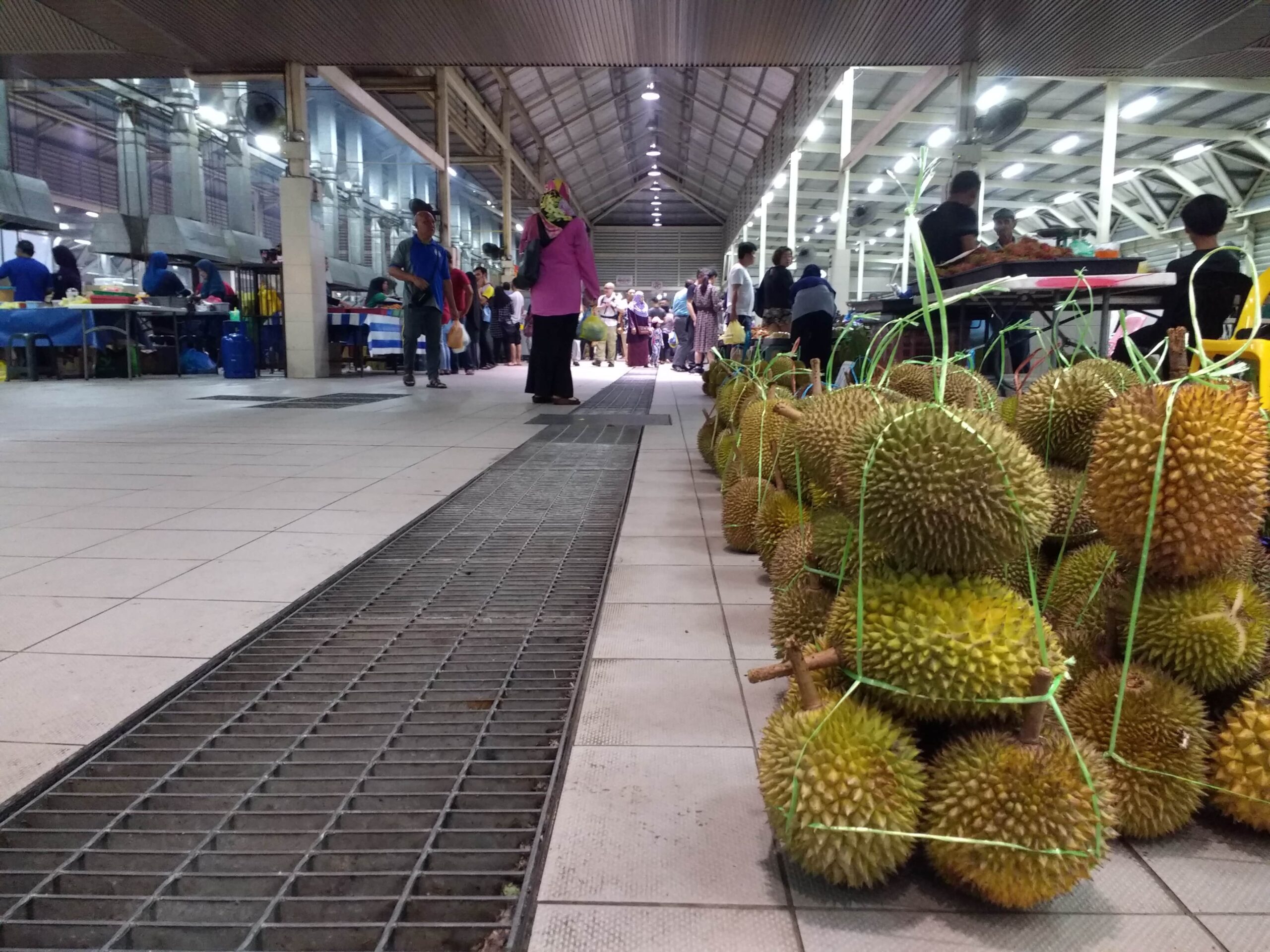

Ulu Temburong National Park
Ulu Temburong National Park was formed in 1991 and is Brunei’s first national park. The park is located in Temburong District in eastern Brunei and covers approximately 40% of the district in the south (550 square kilometers). It is located within Batu Apoi Forest Reserve. The park is renowned as the “Green Jewel of Brunei” and is hailed as “the greatest illustration of the sultanate’s effective forest conservation strategy.” The two main rivers are the Temburong and Belalong. It is an important ecotourism destination in Brunei, and it is home to the Ulu Ulu Resort. The region also includes the Peradayan Forest Reserve. This lovely national park is located in the eastern section of Brunei and is also known as the Brunei’s Green Jewel. Ulu Temburong is ideal for eco-tourists and wildlife aficionados. The virgin rainforest is home to unique wild species such as rhinoceros, hornbills, multiple colonies of swinging gibbons, and the occasional clouded leopards.
7-day Itinerary in Brunei
Day 1
Arrive at Bandar Seri Begawan
Brunei’s capital is a fascinatingly bizarre location where the Sultan’s extravagance clashes with traditional Borneo country life. It works somehow, and while there is a suggestion of being dressed to please, it is nowhere near as flashy as other oil-rich cities like Ashgabat and Baku.
After settling in, and if your first day allows you do explore, start by heading to the domed structure in the capital, which houses the Sultan of Brunei’s regalia. Royal symbols will be seen in coronations, jewel-studded crowns, gilded weapons, and traditional attire. The Sultan personally inaugurated it in 1992.
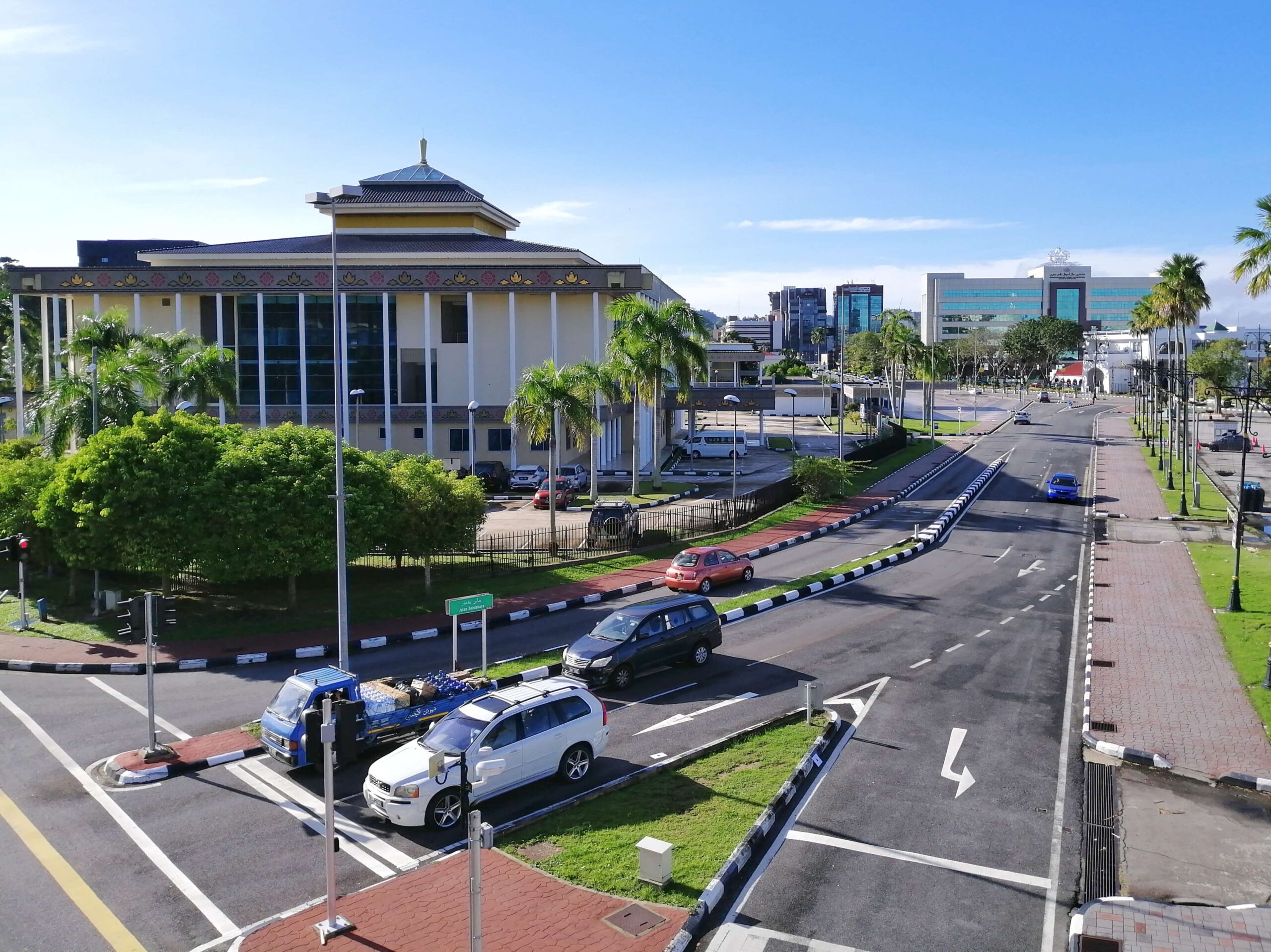
Next up head to Sungai Kebun Bridge. The Queen Saleha Bridge, named after the Queen consort of the present Sultan of Brunei, is the world’s second-longest single-pylon cable-stayed bridge, having been completed in 2017. From here, you can view the “floating hamlet” (Kampung Ayer) in all its beauty.
When you’re done make your way to Taman Haji Sir Muda Omar Ali Saifuddien. This historic city garden setting – where the country declared its independence from the United Kingdom in 1984 – holds a particular place in the hearts of all Bruneians. It is currently utilized for parades, such as those celebrating the Sultan’s birthday or the country’s National Day on February 23rd.
Then, walk to Omar Ali Saifuddien Mosque. Brunei’s most well-known and photographed site is near the city garden and your next stop on your Brunei itinerary. The golden-domed Omar Ali Saifuddien Mosque, which rests on an artificial lagoon, is a 20th-century monument to Islam and the country’s Muslim population. The oil-rich extravagance is stunning, and no cost was spared in its development.
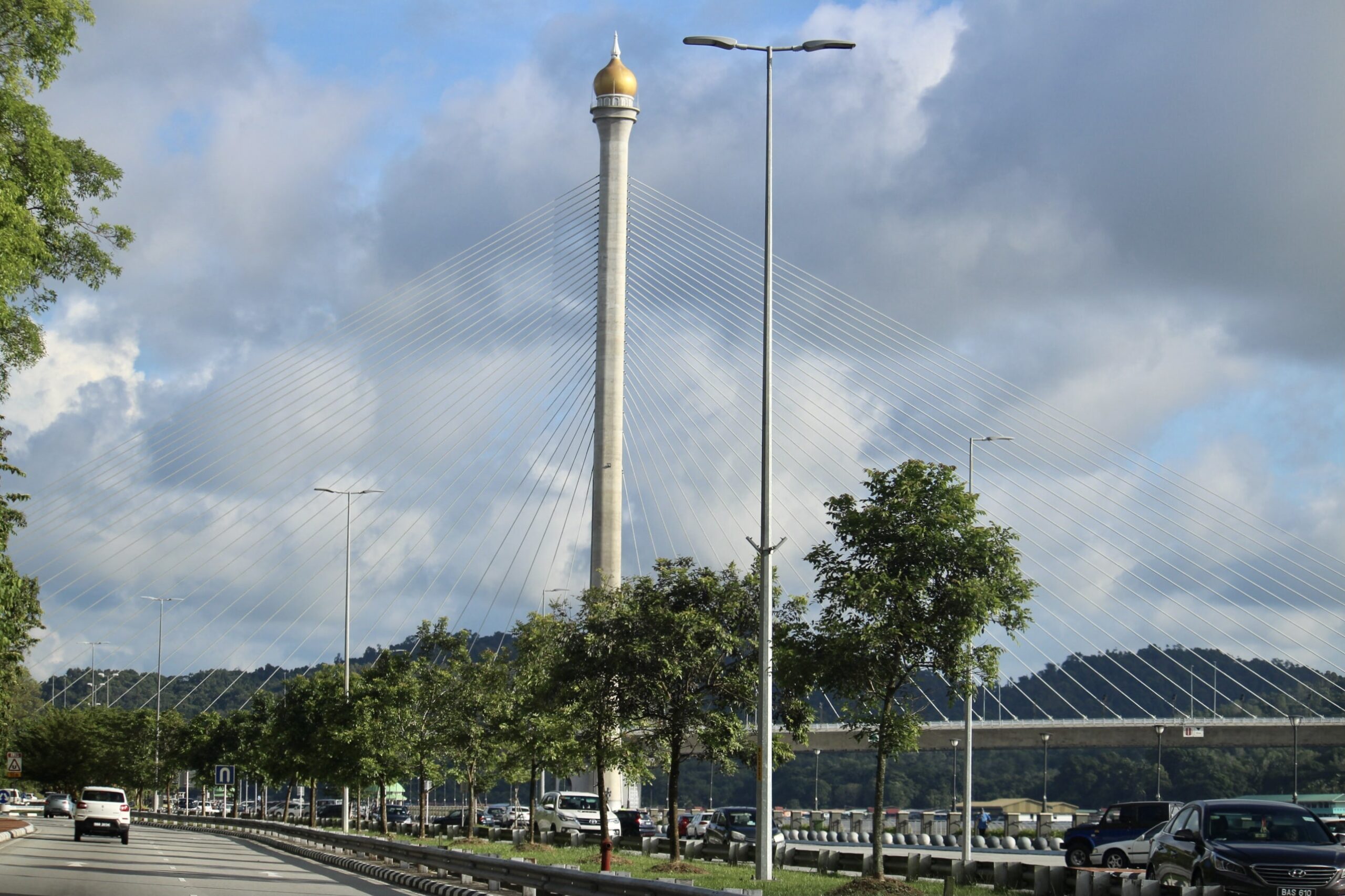
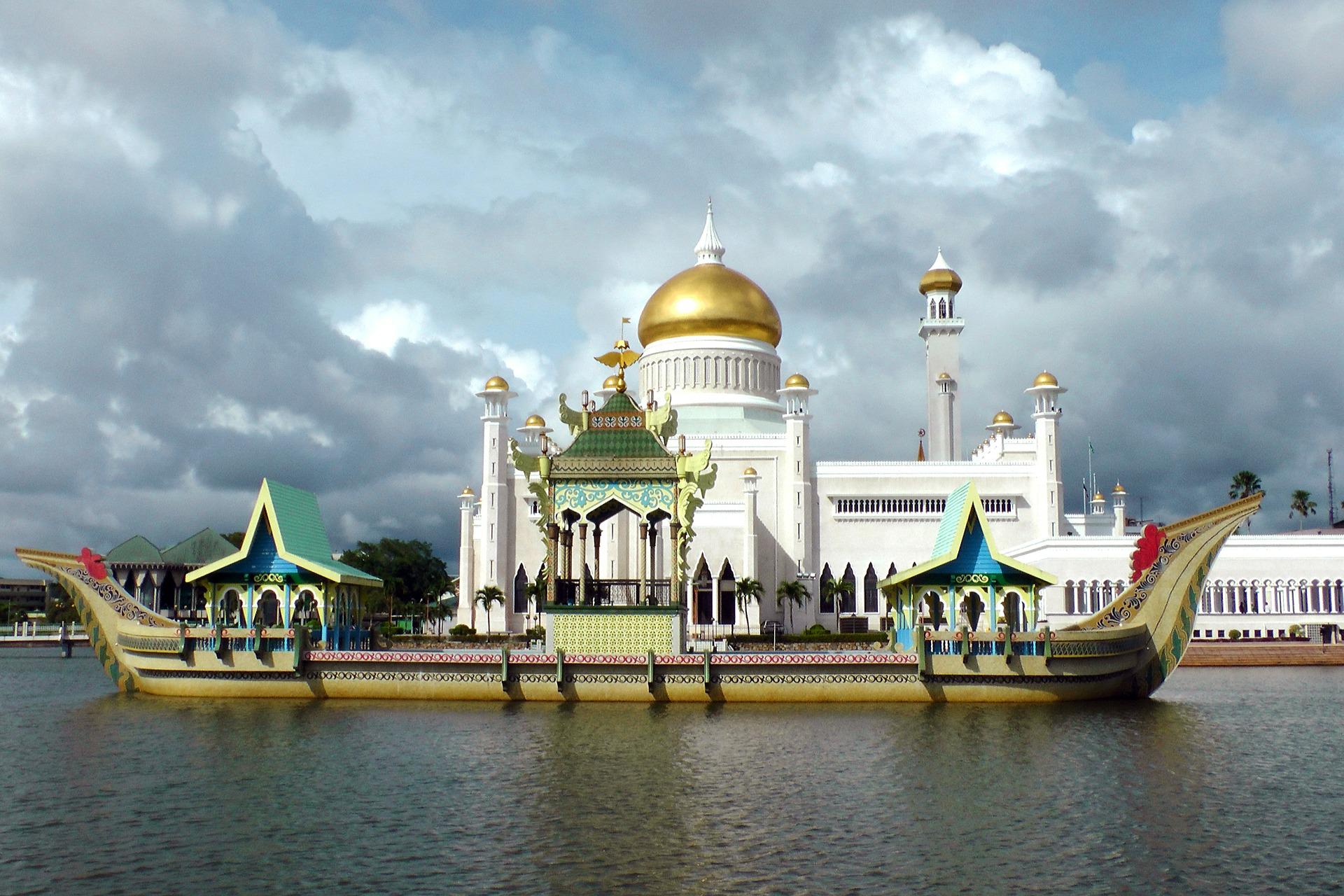
After lunch, head to Tasek Lama Waterfall Park. It’s an oasis of peace in the center of the city, and a terrific place to observe some unique flora and wildlife. Over 80 bird species have been documented there – a bit of Borneo jungle in the city.
Later, pass by Istana Nurul Iman, the official home of Brunei’s Sultan, Hassanal Bolkiah. He is the world’s second-longest reigning king and one of the richest persons on the globe, with an estimated net worth of $20 billion (after Queen Liz in the UK). You may picture the magnificence of his property, which is located southwest of the capital on the banks of the Brunei River. It is the world’s largest residential palace in terms of floor size.
When you’re done eyeballing the structure, make your way to Kampung Ayer, sometimes known as the “Venice of the East,” which literally translates as “water village.” It dates back several centuries and today, houses 30,000 people, making it the world’s biggest Malay floating hamlet. During your tour, you’ll get an eye-opening historical and cultural lesson about how people live and work in houses on stilts in the sea. A must-see on every Brunei itinerary.
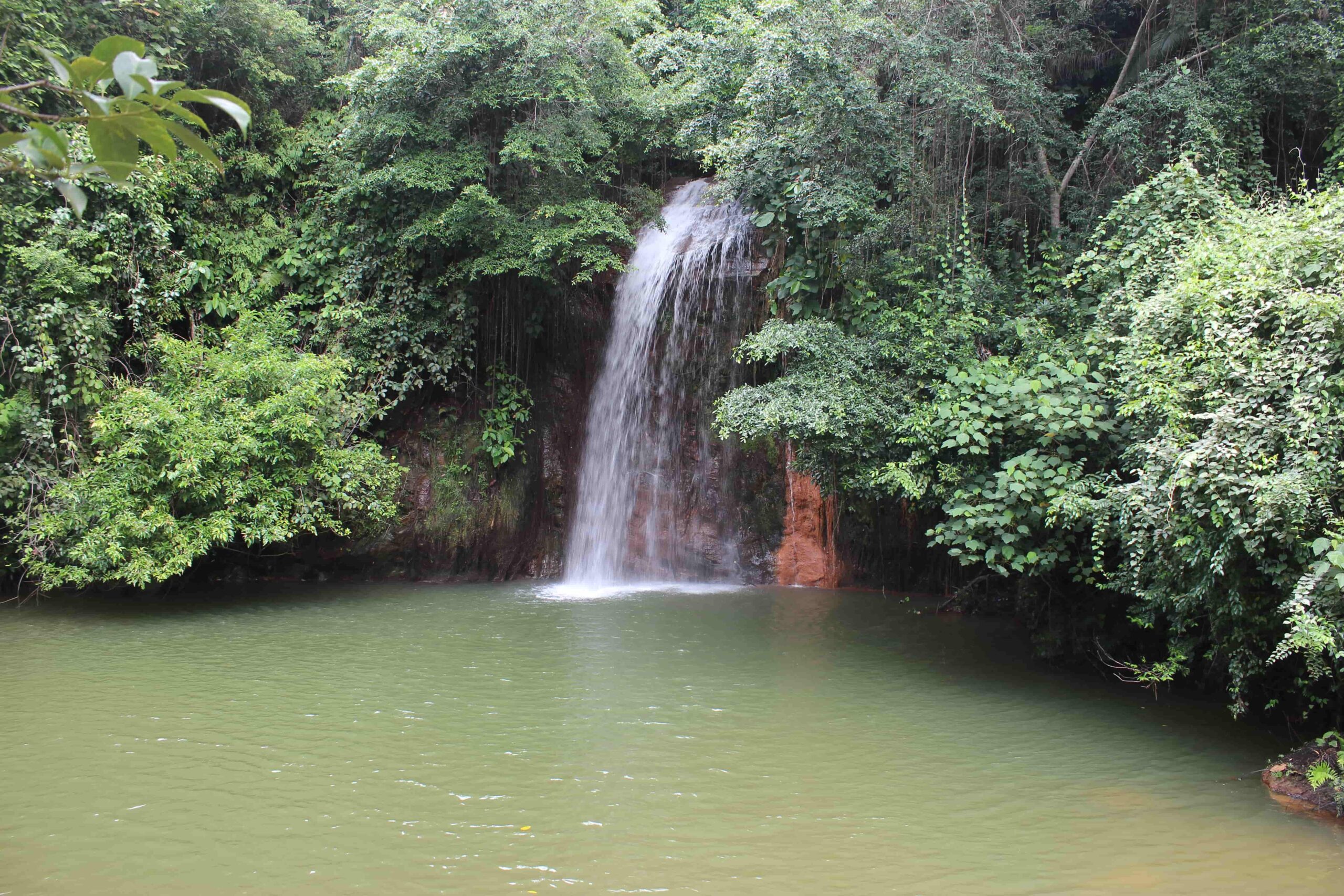

Day one of your Brunei trip concludes with a visit to the colorful and bustling Gadong Night Market. Here you may experience the sights, sounds, and scents of a street food hotspot, as well as feast yourself on as many local specialties as you can. Gadong is unaffected by the overwhelming tourist that plagues other Asian night markets, so you can dine like the locals.
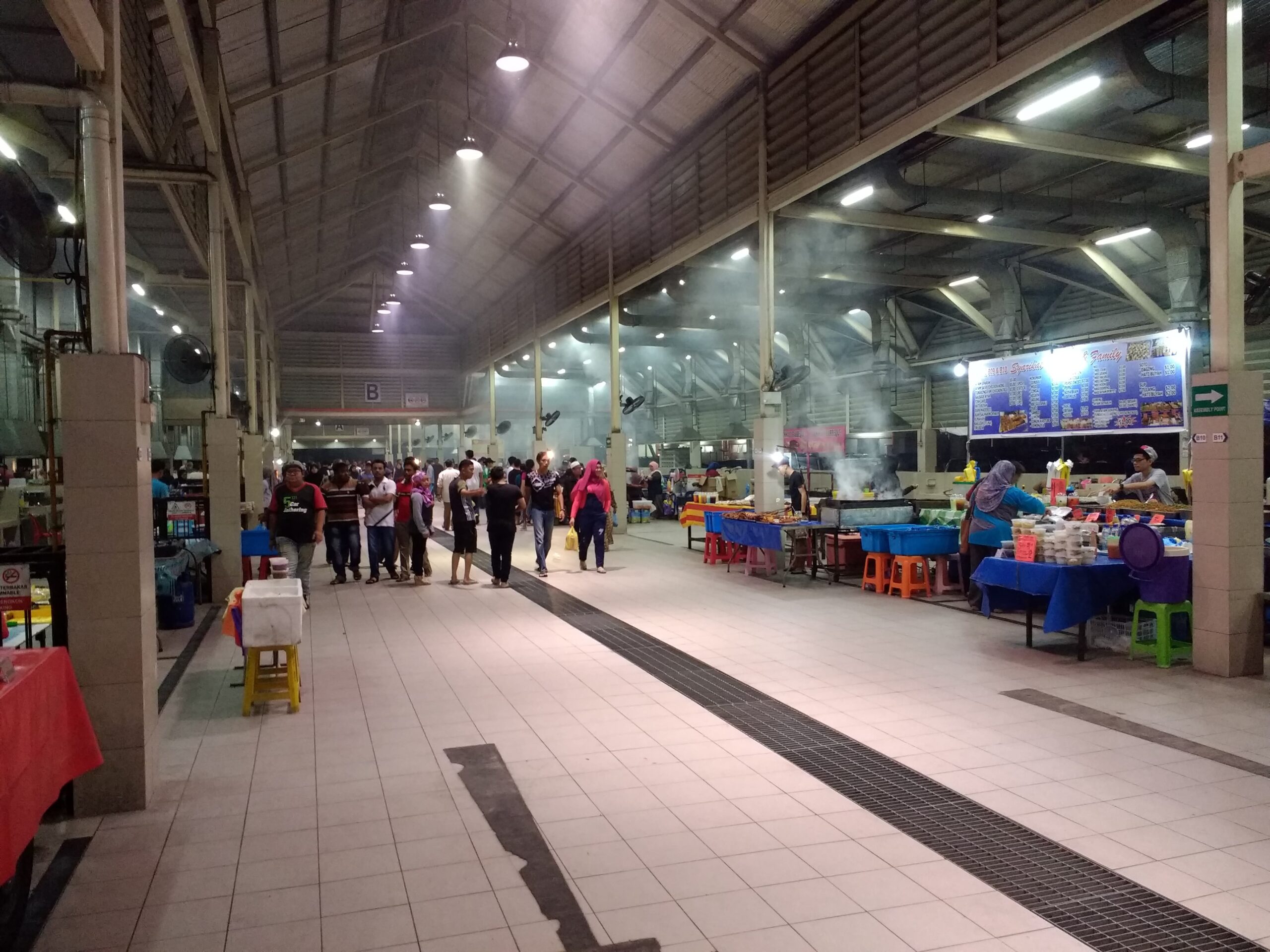
- Backpacker: Youth Hostel, Poni Homestay, Higher Hotel, Prime Hotel
- Budget: Jubilee Hotel, Ginasuite, Badi’ah Hotel, Traders Inn
- Mid-range: Wafa Hotel, Capital Residence Suites, The Centrepoint Hotel
- Luxury: The Rizqun Hotel, The Brunei Hotel, Radisson Hotel, Rimbun Suite, The Empire Brunei
This section will be added shortly.
Day 2
Scuba Dive
Those of you who have done some scuba diving before and have an open water certification can incorporate some undersea tourism into your Brunei trip. But don’t worry if you’re a total beginner; you can learn to scuba dive here and see if this addicting and exhilarating hobby is right for you.

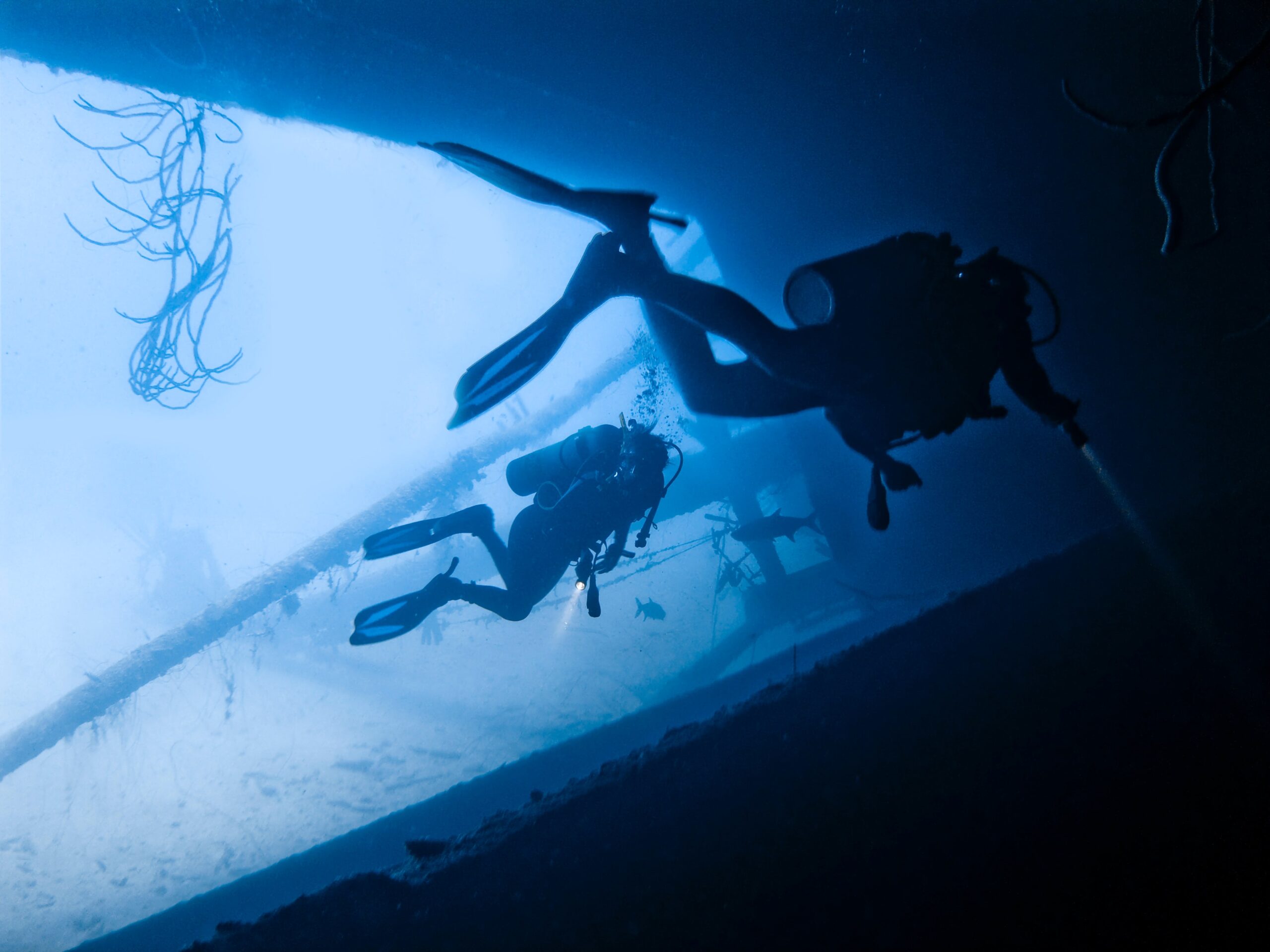
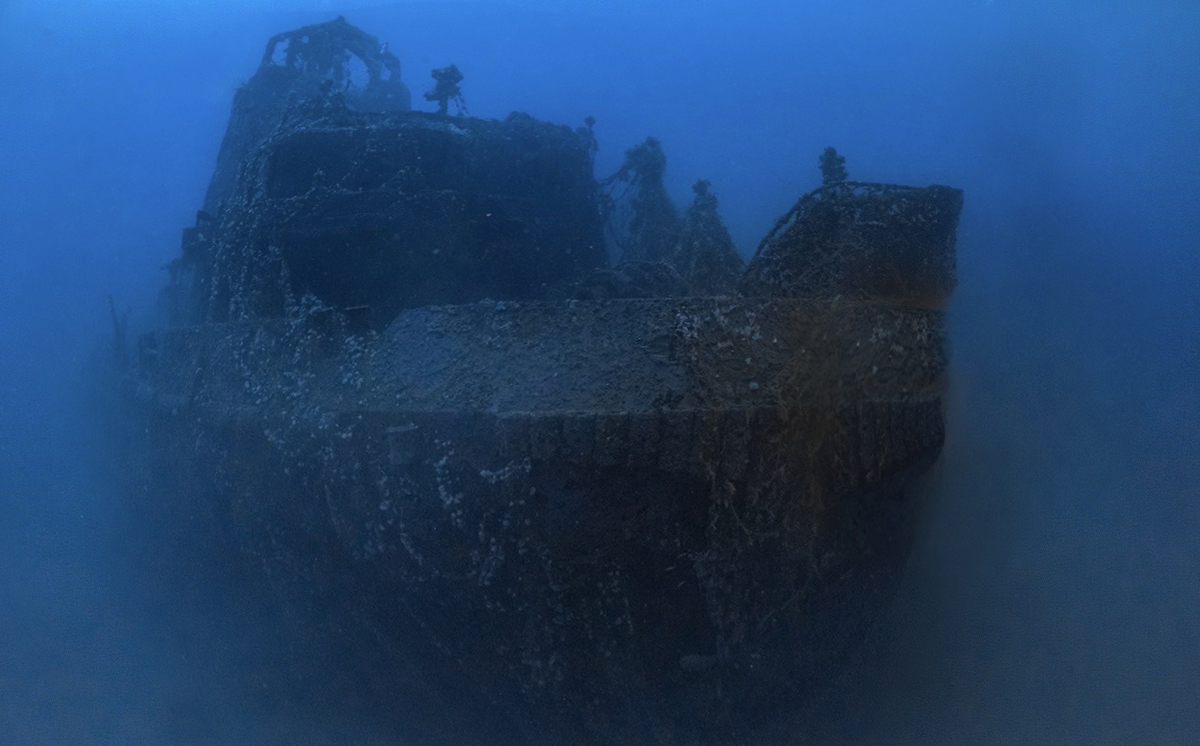
Day 3
Wreck Dives
Scuba diving is one of the finest things to do in Brunei since the country is quickly becoming known for its outstanding wreck diving spots. The island of Borneo is ideal for both expert and novice divers, thanks to its warm, tropical seas and outstanding underwater visibility.
Because no vessel with the Brunei Royal name can be sold for scrap, the Brunei Royal Navy sank a 1955 passenger ship in 1992 to create an artificial reef. Because of its accessibility for divers of all skills, it is now one of Brunei’s most popular dive destinations. It has completed its purpose on the sea and now serves underneath it as a magnificent swarm of colorful aquatic life.
The oil rig wreck is another famous diving destination in these seas, located about 30 minutes by boat from Muara harbor in Bandar Seri Begawan. It’s a great place for novices and is sunk as part of a “rigs to reefs” program to help with marine conservation. The oil rig, which was decommissioned in the late 1980s, has been expanded throughout the years and is now one of the must-see wrecks off the shore of the city
Day 4
Choose a National Park to Explore
Depending on what you wish to do, you can tailor a Brunei travel trip to your tastes. But, it would make sense to shift gears into a different activity, do you fancy the greenery?
You might want to visit the Pulau Selirong mangroves in the beautiful Labu forest reserve. Ulu National Park in Temburong offers a rainforest canopy trek and amazing wildlife sightings. Tubing and crocodile spotting would be an exciting experience (tubing should not be in crocodile territory). An overnight trip around Tasek Merimbun, the country’s largest natural lake, will bring you up close to the island’s natural treasures.


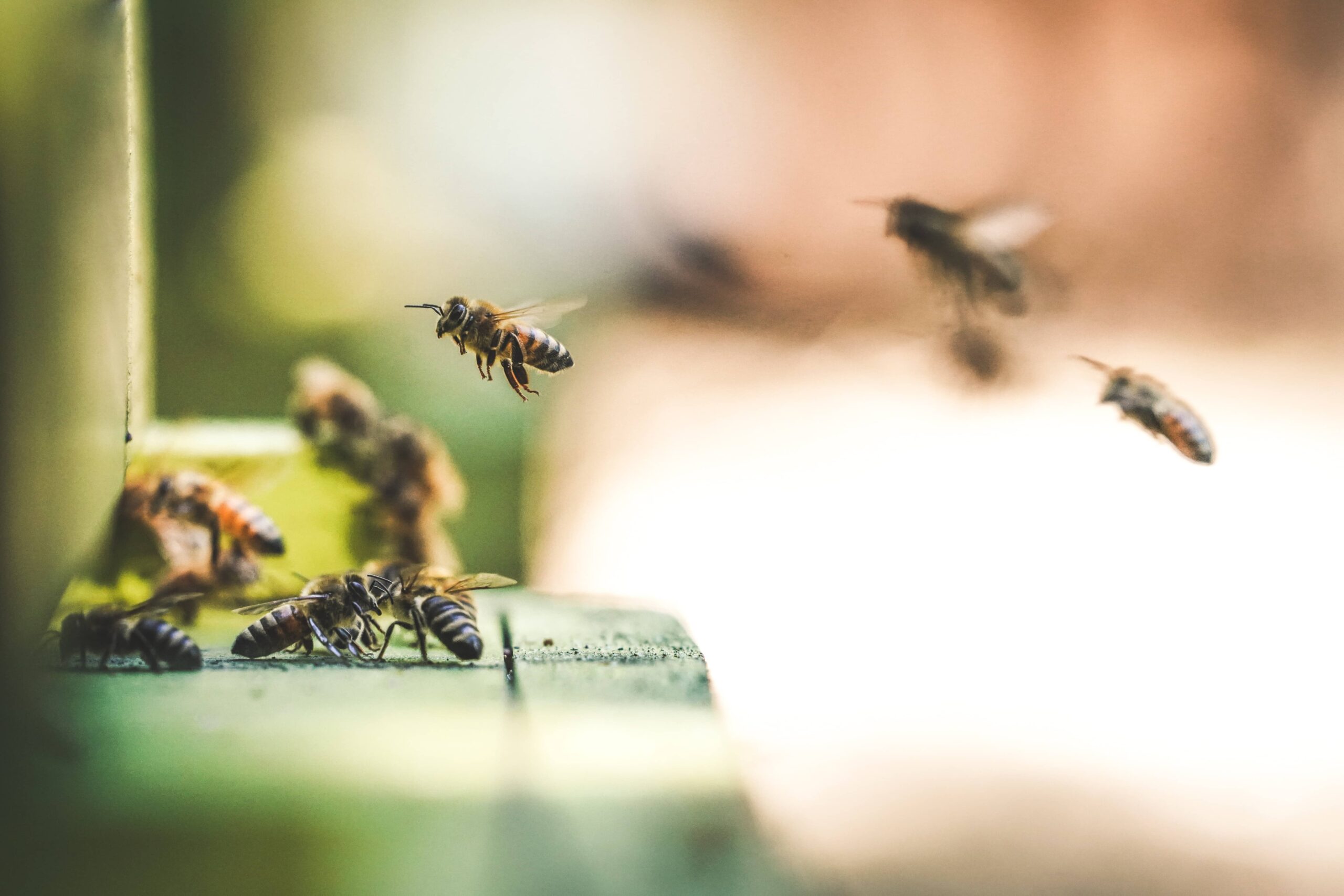
Day 5
A Cultural Conclusion
The final day of your Brunei plan is another jam-packed day of touring and adventures, trying local food, going even further into nature, and mixing with the locals…
First off, after breakfast, head to Tasbee Stingless Bee Farm. This amazing eco-farm can be found in Bandar Seri Begawan’s Tutong area. It is here that you may practice the ancient beekeeping. You don’t need any prior expertise or protective gear. These bees are simply stingless! You can buy a jar of stingless bee honey for $3 here, and you can even gather the nectar yourself.

When you’re done, wander around Eco Ponies Garden. It was founded in 2015 with the goal of boosting community tourism and agriculture while championing sustainable living. It’s a peaceful, off-the-grid refuge where you’ll meet friendly people, learn how to live off the land, and reconnect with nature. A therapeutic experience that will cleanse both the mind and the body – inside and out!
A sign on a fence reads “There is no wifi in this garden, but I promise you’ll have a better connection,” which promises peaceful breaks.
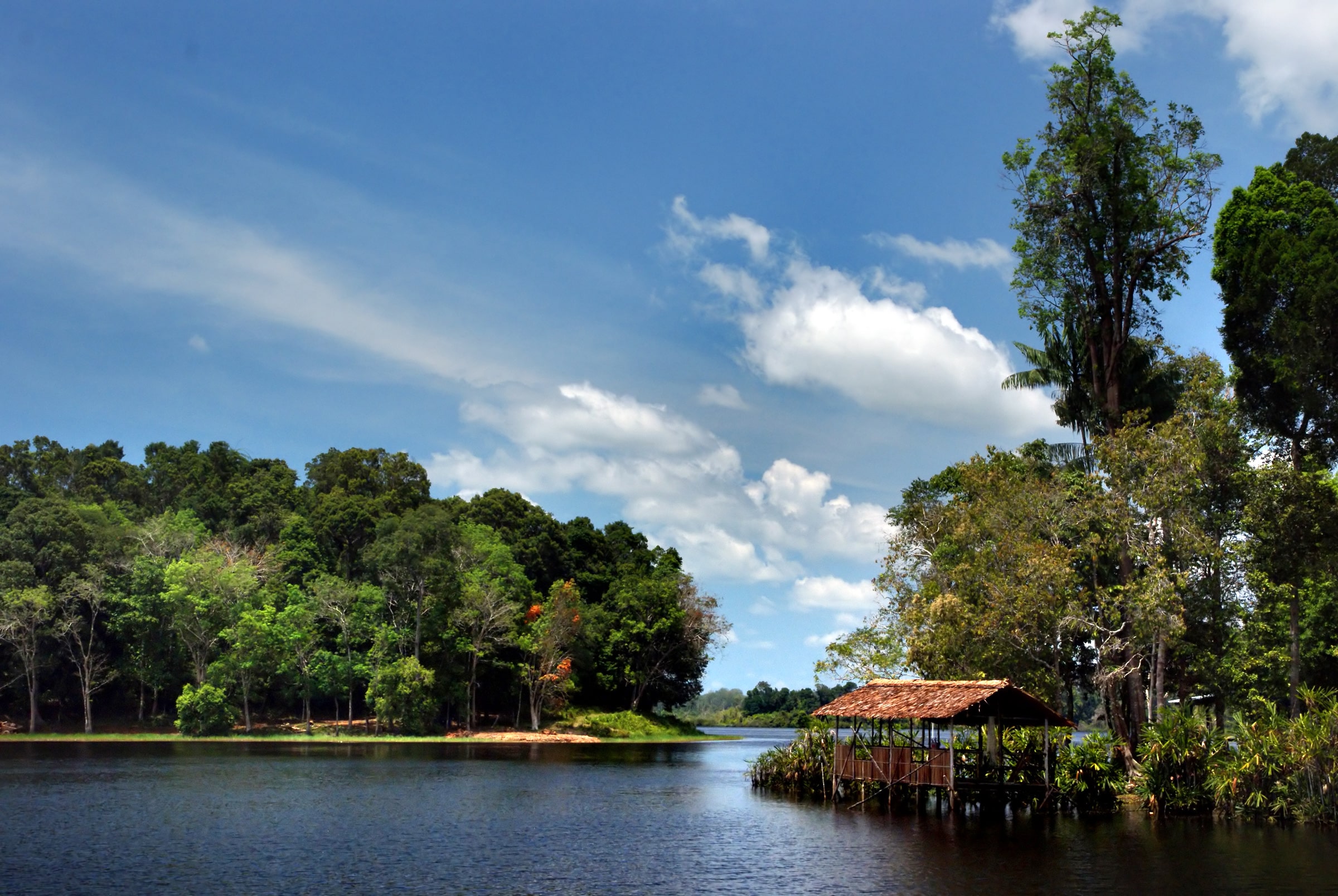
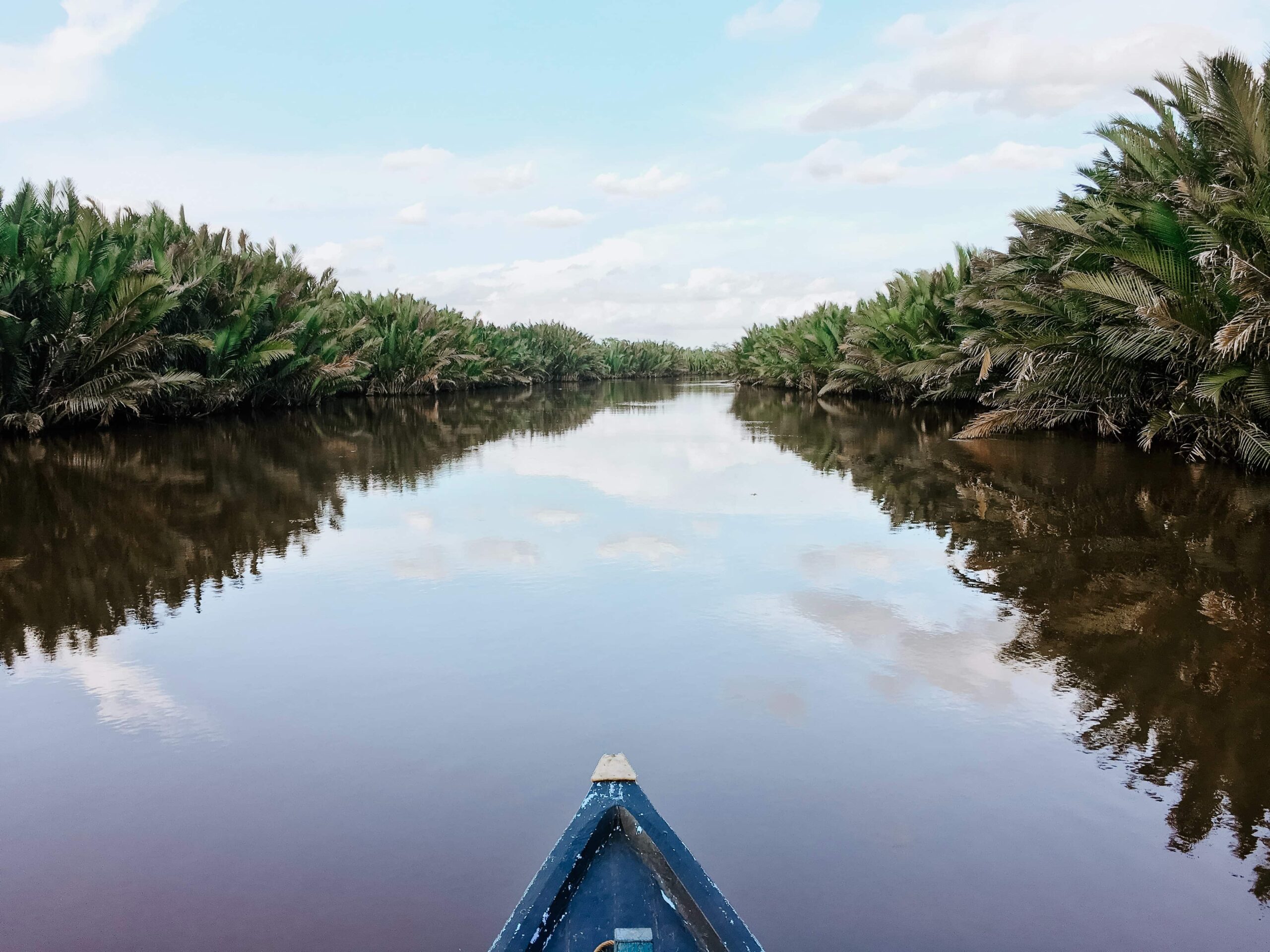
Next up, head to Tasek Merimbun, the island’s largest natural lake. Situated around 70 kilometers from the city and is surrounded by a 7800-hectare heritage park where vital conservation work is done.
It is possible to spend some time there wandering the trails, sailing the lake, and going on bird viewing expeditions at dawn and night. There is also a mini-museum dedicated to the region’s natural heritage.
Conclude your last day with a Mangrove tour, if you haven’t done one already. This is where you can witness an abundance of animal and plant life from the comfort of your moving seat, be sure to be with a guide, of course.
You’re likely to encounter the proboscis monkey, which is only found in Borneo, as well as a variety of birds and if you’re lucky, a curious crocodile. Nature lovers, rejoice — this is a fantastic experience that will bring your Brunei travels to a conclusion.
Day 6
Departure from Brunei
If you have time, you can go for a walk until your flight arrives. If not, you may depart and proceed to the Brunei airport. If you haven’t noticed when you touched base in Brunei, the airport’s building is just as magnificent as the rest of the structures lining the country and it sure gives you a good last look before you leave. Bid Brunei farewell and head to your terminal.
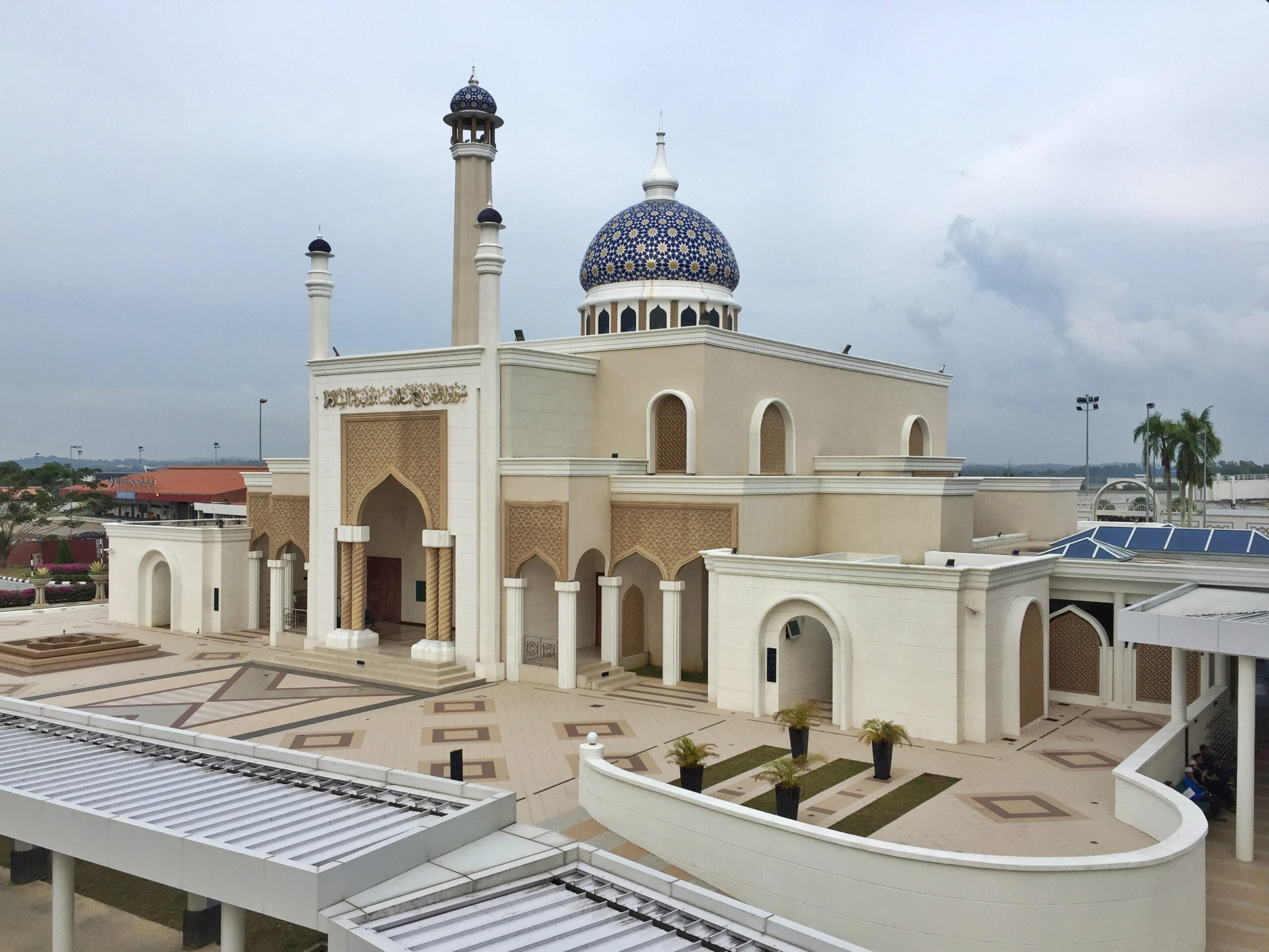
The Most Popular Food in Brunei
Brunei’s cuisine is greatly inspired by its neighbors Malaysia, Indonesia, and Singapore, as well as influences from India, China, Thailand, and Japan. Food in the country is halal; similar to kosher. Fish and rice are basic meals, as is usual in the region, however meat is pricey and so less prevalent. Because of the Islamic religion’s supremacy, the food is halal, which means no pork. Brunei prohibits the use of alcoholic beverages. Game animals such as wild birds, sambar deer, and barking deer are hunted in rural regions.
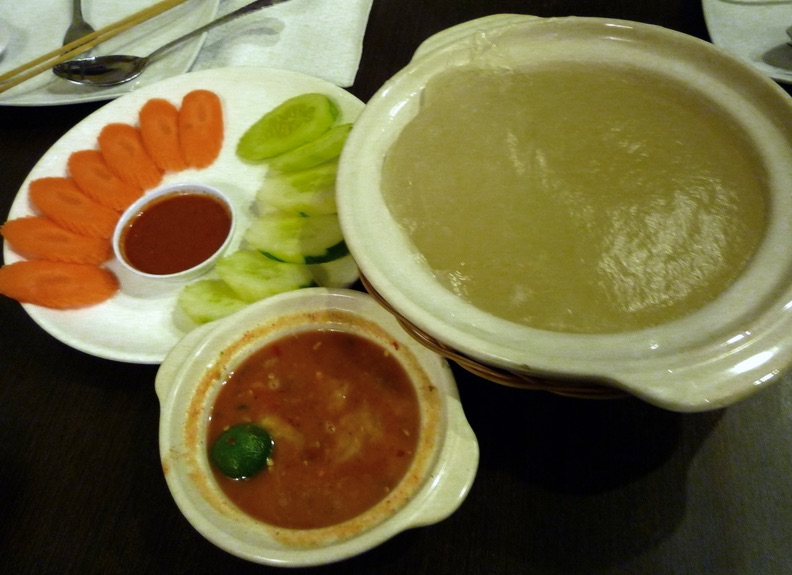
Ambuyat
Brunei’s national dish, ambuyat, has a distinct look. It appears to be aloe vera gel. It is prepared, however, with the interior of sago palm plants. This component produces a mixture of water and white solids. A dip called cacah is used with ambuyat to enhance the flavor. It is pretty sour and spicy.
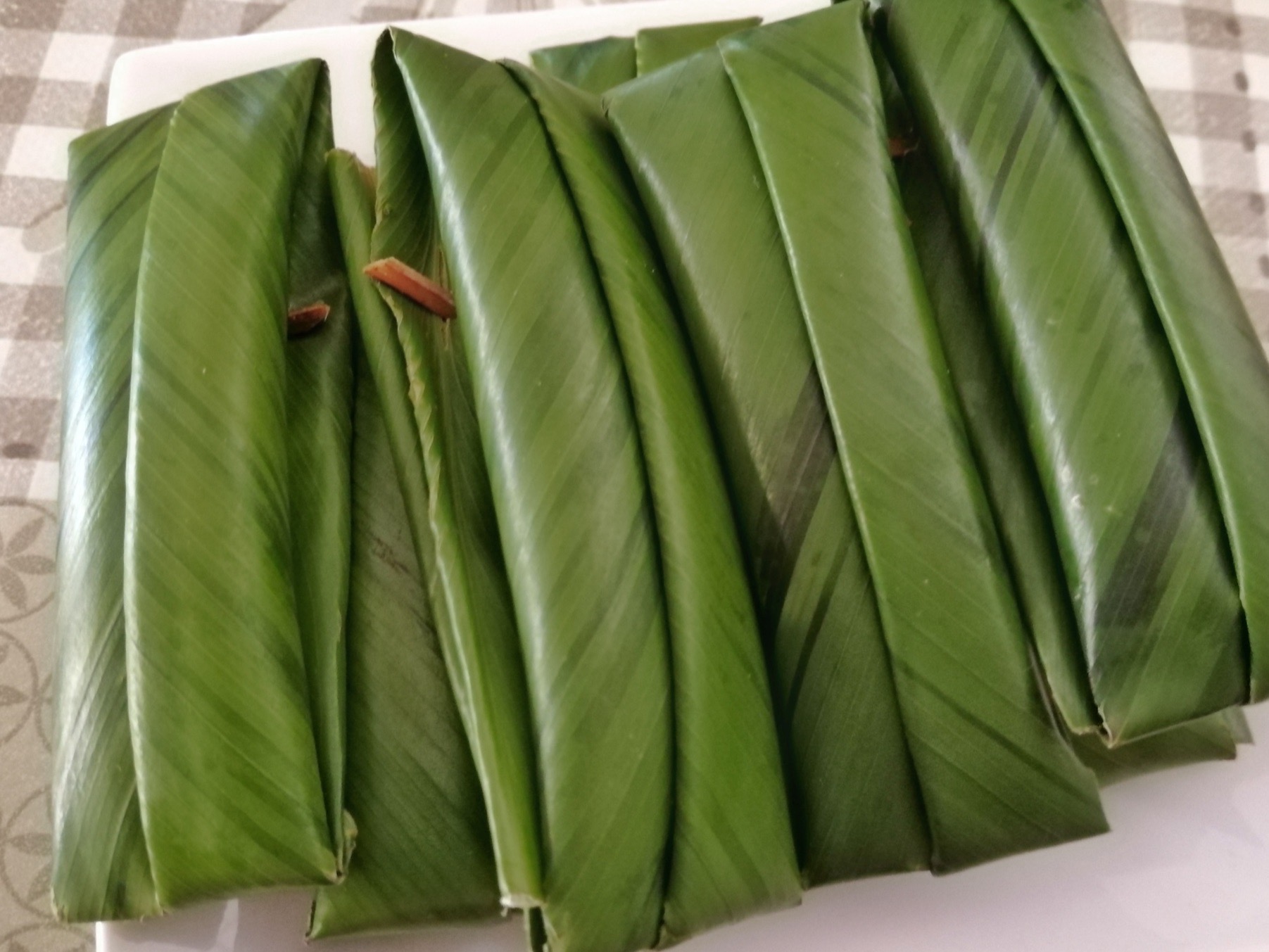
Kelupis
Kelupis is a delicious snack. Rice is cooked with various ingredients such as coconut milk and pandan leaves to make this dish. After that, it is wrapped with Daun nyirik leaves. To eliminate extra water, the rolls are cooked again and hung.

Nasi Katok
Nasi means rice, but katok literally means “knock.” The surname has a lengthy history. There are several recipes for making nasi katok. Few elements, such as the fried chicken piece, rice, and the delectable sambal dip, remain consistent throughout all variations.

Pulut Panggang
Pulut panggang is the name given to this popular Brunei food. This dish is wrapped and grilled. Steaming the wrapped component is not a viable option. It is typically eaten for breakfast, and the locals adore it; you must try it as well.
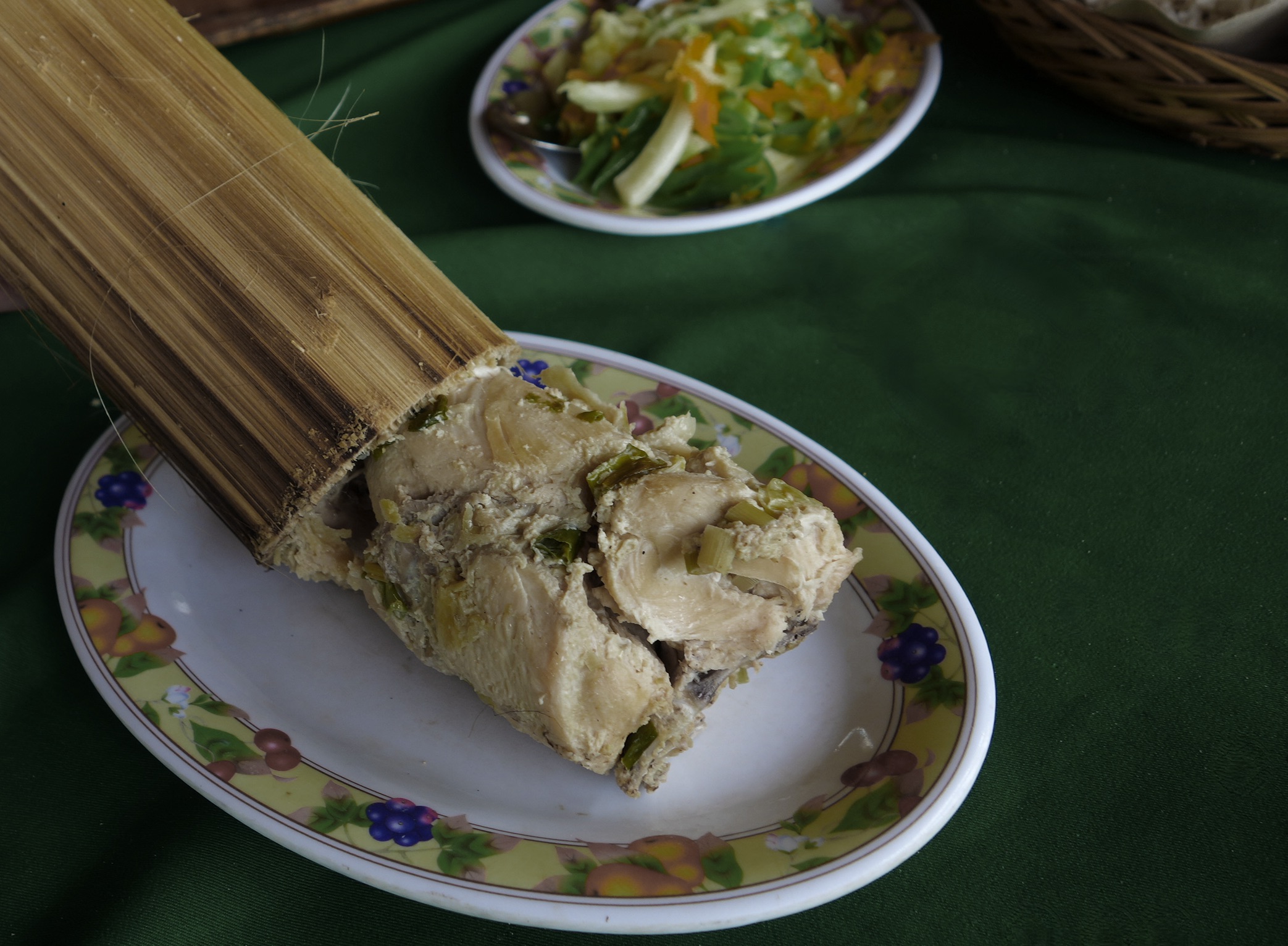
Bamboo Chicken
Bruneian cuisine is distinguished for bamboo chicken. It’s created by packing chicken inside bamboo poles. Make careful, though, to marinade the chicken first. Other components include spices and onions, in addition to the chicken. The bamboo leaves are then used to wedge it shut.
What's the Travel Budget for Brunei?
Flights
- Flights start at roughly $130 from nearby countries. Tickets however on average cost around $400 and can cost way more depending on which class and from which country you depart from.
Accommodation
- Nomad Backpacking style travelers can expect to spend around $100 for a week
- Budget travelers can expect to spend around $170 for a week
- Mid-range travelers can expect to spend around $450 for a week
- Luxury travelers can expect to spend around $1200 for a week
Food Budget (Three meals and drinks)
- Nomad Backpacking style travelers can expect to spend around $10 per person per day
- Budget travelers can expect to pay around $15 per person per day
- Mid-range travelers on average would cost $25 to $35 per person per day
- Luxury travelers can expect to pay around $40 to $55 per person per day
Overall Budget Styles (Not including Flights, Tours, Transportation, or Car Rental)
- Nomad Backpacking style travelers can expect to spend roughly $200 for a week
- Budget travelers can expect to spend close to $350 for one person for a week
- Mid-range travelers can expect to spend approximately $720 for one person for a week
- Luxury travelers can expect to spend around $1,630 for one person for a week
Flights
- Flights start at roughly $130 from nearby countries. Tickets however on average cost around $400 and can cost way more depending on which class and from which country you depart from.
Accommodation
- Nomad Backpacking style travelers can expect to spend around $100 for a week
- Budget travelers can expect to spend around $170 for a week
- Mid-range travelers can expect to spend around $450 for a week
- Luxury travelers can expect to spend around $1200 for a week
Food Budget (Three meals and drinks)
- Nomad Backpacking style travelers can expect to spend around $10 per person per day
- Budget travelers can expect to pay around $15 per person per day
- Mid-range travelers on average would cost $25 to $35 per person per day
- Luxury travelers can expect to pay around $40 to $55 per person per day
Overall Budget Styles (Not including Flights, Tours, Transportation, or Car Rental)
- Nomad Backpacking style travelers can expect to spend roughly $200 for a week
- Budget travelers can expect to spend close to $350 for one person for a week
- Mid-range travelers can expect to spend approximately $720 for one person for a week
- Luxury travelers can expect to spend around $1,630 for one person for a week
Flights
- Flights start at roughly $130 from nearby countries. Tickets however on average cost around $400 and can cost way more depending on which class and from which country you depart from.
Accommodation
- Nomad Backpacking style travelers can expect to spend around $100 for a week
- Budget travelers can expect to spend around $170 for a week
- Mid-range travelers can expect to spend around $450 for a week
- Luxury travelers can expect to spend around $1200 for a week
Food Budget (Three meals and drinks)
- Nomad Backpacking style travelers can expect to spend around $10 per person per day
- Budget travelers can expect to pay around $15 per person per day
- Mid-range travelers on average would cost $25 to $35 per person per day
- Luxury travelers can expect to pay around $40 to $55 per person per day
Overall Budget Styles (Not including Flights, Tours, Transportation, or Car Rental)
- Nomad Backpacking style travelers can expect to spend roughly $200 for a week
- Budget travelers can expect to spend close to $350 for one person for a week
- Mid-range travelers can expect to spend approximately $720 for one person for a week
- Luxury travelers can expect to spend around $1,630 for one person for a week
Flights
- Flights start at roughly $130 from nearby countries. Tickets however on average cost around $400 and can cost way more depending on which class and from which country you depart from.
Accommodation
- Nomad Backpacking style travelers can expect to spend around $100 for a week
- Budget travelers can expect to spend around $170 for a week
- Mid-range travelers can expect to spend around $450 for a week
- Luxury travelers can expect to spend around $1200 for a week
Food Budget (Three meals and drinks)
- Nomad Backpacking style travelers can expect to spend around $10 per person per day
- Budget travelers can expect to pay around $15 per person per day
- Mid-range travelers on average would cost $25 to $35 per person per day
- Luxury travelers can expect to pay around $40 to $55 per person per day
Overall Budget Styles (Not including Flights, Tours, Transportation, or Car Rental)
- Nomad Backpacking style travelers can expect to spend roughly $200 for a week
- Budget travelers can expect to spend close to $350 for one person for a week
- Mid-range travelers can expect to spend approximately $720 for one person for a week
- Luxury travelers can expect to spend around $1,630 for one person for a week
If you want to know what to pack, read this list below:
- This is a conservative tropical country that can get extremely hot or too rainy, dress accordingly
- Raincoat or Light Waterproof Jacket
- Hiking Boots or Sturdy Sneakers (Shoes You Don’t Mind Getting Wet)
- Sunscreen
- Insect Protection – Repellent and Clothing
- Sunglasses and Sun Hat
- Water Shoes
- Beach Towels/Sarong
- Dry Bag
- Money Belt or Cross Bag
- Portable Medical Kit
- Flashlight or Headlamp
- Copies of your passport.
- Get all the needed vaccinations before traveling
- A power bank is a must in any travel.
- Always have some cash with you just in case there are no ATMs and if you are dealing with a business that solely accepts cash
- Get yourself an adapter for your gadgets
- 1 toothbrush
- 1 tube of toothpaste
- 1 razor
- 1 package of dental floss
- 1 small bottle of shampoo
- 1 small bottle of shower gel
- 1 towel
- Deodorant
- Band-Aids
- Hydrocortisone cream
- Antibacterial cream
- Earplugs
- Tylenol
- Hand sanitizer (germs = sick = bad holiday)
- A key or combination lock
- Zip-lock bags
- Plastic bags (great for laundry)
- Universal charger/adaptor
- LifeStraw (A water bottle with a purifier)
- 1 dry shampoo spray & talc powder
- 1 hairbrush
- Makeup you use
- Hairbands & hair clips
- Feminine hygiene products
Clothing For Boys
- 1 pair of jeans or khaki pants
- 1 pair of shorts
- 1 bathing suit
- 5 T-shirts
- 1 long-sleeved T-shirt
- 1 pair of flip-flops
- 1 pair of sneakers
- 6 pairs of socks
- 5 pairs of boxer shorts
Clothing For Girls
- 1 swimsuit
- 1 sarong
- 1 pair of stretchy jeans
- 1 pair of leggings
- 2-3 long-sleeve tops
- 2-3 T-shirts
- 3-4 spaghetti tops
- 1 light cardigan
Want to plan your own trip, here are some of the best resources that can help you
- Skyscanner – They search small websites and budget airlines that larger search sites tend to miss. They are hands down the number one place to start.
- Momondo – This is another favorite flight search engine because they search such a wide variety of sites and airlines. Always check here too.
- Booking.com – The best all-around booking site that constantly provides the most affordable and lowest rates. They have the widest selection of budget accommodation.
- Couchsurfing – This website allows you to stay on people’s couches or spare rooms for free. It’s a great way to save money while meeting locals who can tell you the ins and outs of their city. The site also lists events you can attend to meet people (even if you’re not staying with someone).
- Intrepid Travel – If you want to do group tours, go with Intrepid. They offer good small group tours that use local operators and leave a small environmental footprint.
- Grassroots Volunteering – For volunteering, Grassroots Volunteering compiles a list of good local volunteer organizations that keep the money within the community.
- Get Your Guide – Get Your Guide is a huge online marketplace for tours and excursions. They have tons of tour options available in cities all around the world, including everything from cooking classes, walking tours, street art lessons, and more! It has the world’s largest collection of things to do with more than 30,000 activities in 7500 destinations.
- SafetyWing – Safety Wing offers convenient and affordable plans tailored to digital nomads and long-term travelers. They have cheap monthly plans, great customer service, and an easy-to-use claims process that makes it perfect for those on the road.
- Trip Advisor: Check the reviews and then book your accommodation. TripAdvisor is where you go when you want to compare prices with multiple accommodation providers.
- VRBO: is the main search engine to use when you are looking for a home or apartment rental. It can sometimes be cheaper than hotels and it is the best way to stay in areas that offer a more local feel.
- Hostelworld: With one of the largest databases of hostels in the world, Hostelworld is the go-to site when you are looking for budget accommodation.
- Rome 2 Rio: If you want to see how to get somewhere by plane, train, bus, ferry, or car Rome2Rio lays it all out for you as well as related costs.
- World Nomads Insurance: When traveling you should always have travel insurance. We have found the best bang for your buck is by far World Nomads.
Final Thoughts on Brunei
The Sultanate of Brunei provides a complex and rich Borneo culture that is visible across the nation, with its empire past, wonderful and distinctive Islamic architecture, hospitable people, and magnificent nature making it so alluring and especially picturesque as a result of this blend. Brunei is therefore a location worth visiting. Brunei’s beauty is striking, from its magnificent National Parks to its wreck dives, natural wonders, and breathtaking scenery. Would you go to Brunei?
Have you ever visited Brunei? Tell us about your journey in the comments section below.